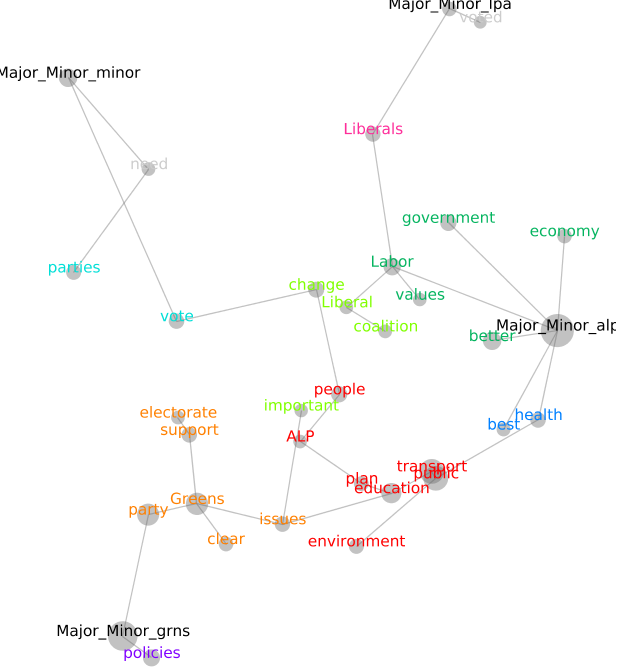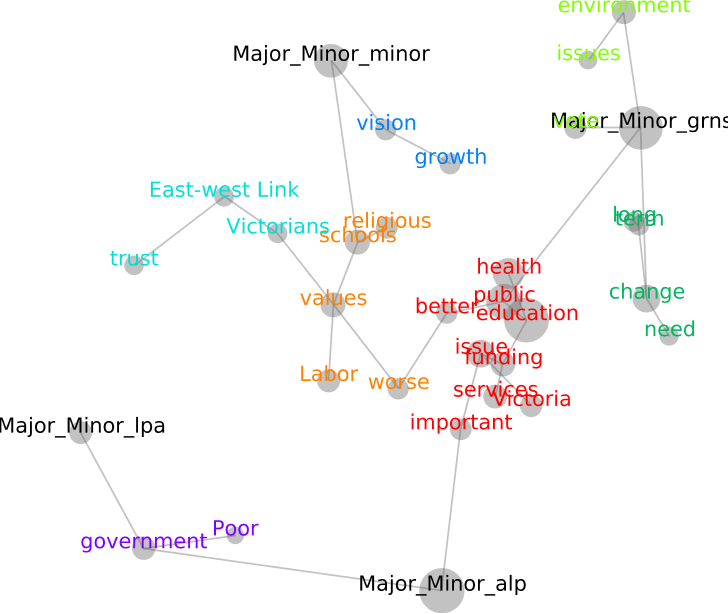Background
To make sense of the result of the Victorian election, one has to take it in the context of the previous election in 2010 when the Liberal Party accidentally became the government in Victoria, unexpectedly winning the 2010 Victorian election.
There was no public expectation that they would win. According to Newspoll, in 2010 55% of voters expected Labor to win, while only 25% expected it to be the Coalition.
Neither party was particularly popular and neither won more than 40% of the vote. Labor had 36.2% of the vote and the Liberals 38%.
Advertisement
That delivered the Liberals a majority of one in both the upper and lower houses.
So while the Libs were there, they were only just there. Liberal premier Ted Baillieu was widely criticised for not acting quickly, or having a coherent program as premier.
There were some controversial decisions with respect to the environment – allowing grazing in Alpine parks and cutting support for alternative energy production. He also cut funding to TAFE (in response to a blowout of hundreds of millions caused by the federal Labor government implementing a program of contestability in the sector).
He was then forced from office when tapes surfaced implicating his chief of staff in undermining the police commissioner, and the government in stymieing a corruption inquiry.
Liberal MLA Geoff Shaw resigned from the party and refused to commit to support it with Baillieu as leader.
That led to the resignation of Baillieu, and the election of Denis Napthine as leader of a minority government.
Advertisement
Subsequently Shaw was found not to have acted diligently with his parliamentary expenses which led to the Liberal Party eventually expelling him, and he threatening to withdraw his support from the government.
Close to the election the government decided to commit to building the eastern end of the East-West Link, and there was controversy about this decision, although polls showed that most voters were in favour of it. The tunnel was first proposed by Jeff Kennett in 1999.
The result
As predicted by the polls Labor won the election. While this was expected, again neither side won more than 38% of the vote (this time it was Labor on the higher figure), so minor party preferences were crucial and the result can't be said to be decisive (anymore than the last result was). The minor party votes were similar to last time, meaning that the real change probably occurred with voters moving between the two major parties (although this is never that simple with voters changing between all parties).
In Victoria a high percentage of Greens preference Labor, while a smaller majority of non-Greens minor party voters preference the Liberals. This gives Labor an advantage when results come down to third party preferences.
Despite the Greens having a very static vote across the state, this time they appear to have won the seat of Melbourne, increasing their vote from 31.92% to 41.42%.
The disillusion and essentially status quo nature of the result is illustrated by the standing of the leaders. According to Newspoll both Napthine and Andrews had very similar negative approval ratings

Source http://polling.newspoll.com.au.tmp.anchor.net.au/image_uploads/141124%20VIC%20Election%20-%20Final.pdf

Source: http://polling.newspoll.com.au.tmp.anchor.net.au/image_uploads/141124%20VIC%20Election%20-%20Final.pdf
And many voters had not made up their minds, indicating that both had made a relatively weak impression on electors.
The result was that voters actually preferred Napthine over Andrews.

Source: http://polling.newspoll.com.au.tmp.anchor.net.au/image_uploads/141124%20VIC%20Election%20-%20Final.pdf
Albeit by a small margin, and again with a large number of uncommitted voters.
So why did Napthine lose if he was the preferred premier, and electors were unenthusiastic about the parties?
Let's deal with some of the reasons advanced by commentators.
Jeff Kennett was quick to direct friendly fire at Abbott, and less friendly fire came from Chris Kenny in the SMH, Laurie Oakes, and others. The Labor Party implicitly appears to have agreed running election advertisements where the faces of Napthine and Abbott merged to become one.
But there is little evidence from our respondents that Abbott was a major reason. Only two people (out of 175) nominated him as the reason for voting against the state government.
Much more significant were alleged cuts to education and health, as well as cuts to TAFE. Other factors cited were lack of transparency around the East-West Link and a lack of investment in public transport, damage done to the environment, discomfit over the rate of development, privatisation and unemployment.
It's probable that Abbott played a part in negative perceptions on some of these issues as the problems at a federal level have damaged the Liberal brand and made it easier to paint it as the party that hates the poor.
For example, there was little factual justification for blaming the state government for cuts to health or education. While they had slowed the growth in spending in these areas to roughly the rate of inflation they had not been cut.
However, at a federal level the refusal of Abbott to extend Gonski and the previous Labor government's health funding arrangements, has been painted by Labor as broken promises and cuts in funding to education and health. So this may well have contributed to a belief amongst electors that the state Liberals had cut these services too.
But if he is taking some blame, it doesn't appear to be a particularly heavy load as demonstrated by these two tables from Newspoll's Victorian polling.

Source: http://polling.newspoll.com.au.tmp.anchor.net.au/image_uploads/130807%20VIC%20Voting%20Intention%20&%20Leaders%20Ratings%20Jul%20-%20Aug.pdf

Source: http://polling.newspoll.com.au.tmp.anchor.net.au/image_uploads/141124%20VIC%20Election%20-%20Final.pdf
The Victorian Liberals had already hit their lowest figure in October 2012, twelve months before Abbott won. There was a slight recovery when Napthine became leader, but this had mostly dissipated by the time Abbott became Prime Minister in September 2013.
There was a decline down to August this year, but it would be heroic to attribute all of this to Abbott when the problems with Geoff Shaw were raging throughout most of that time.
So, if there were an Abbott effect it is pretty hard to discern.
Another argument advanced is that the union base of the Labor Party ran a particularly effective door-knocking campaign in a number of seats, and this made the difference. According to former ALP State Secretary Nicholas Reece, they made 500,000 phone calls, door-knocked 170,000 homes with half the calls and a quarter of homes in 6 marginal seats.
I suspect Mr Reece is talking his book, because when you look at these marginal seats the swings are not out of the ordinary.
According to Antony Green, on the night the average swing to Labor on first preferences was 1.8%, so prima facie you need to do better than that to be able to claim a success. It turns out that of the 6 seats nominated, three do worse than the average swing, so we can say either that the campaign made no difference, or that the Liberals lifted to match it.
That leaves three seats where the unions may have had an effect, and the swings here were impressive – 3.4%, 6.0% and 8.0%. However, two were actually held by Labor, but notionally Liberal because of redistributions, and the other was held by Liberals, but also suffered a major redistribution.
So the results are really only large in seats where a new group of voters was up for grabs, and seem to rely heavily on incumbency in the first place. In two of the three it's just as likely that being the local member, with all the resources this entails, made the difference over a challenger. This table lists the seats.

Source: http://www.abc.net.au/news/vic-election-2014/results/
Still, only 9 seats swung to the Liberals, and none by margins that suggested their on-the-ground-campaign was particularly effective, so the ground campaign probably counted for something.
Why our respondents voted them out
I put the data into Leximancer, semantic software that we use to analyse large qualitative samples. Generally when I put voting data into Leximancer it constructs a map with Labor and Liberal voters at opposite ends. The economy and debt dominate the Liberal end and social goods like education and health the other. There is also generally a lot of mentions of the opposing leaders.
This is the map that it constructs for voting intention in the last Victorian election.

Figure 1: Thinking about your first preference vote, in a short sentence tell us why you answered that way?
The parties are arranged in a rectangle with Liberal and Labor sharing one side and the economy is more closely linked to the ALP than it is to the Liberals. Neither of the leaders is mentioned. The Greens are distant from every other political party, and most of the issues of substance such as education, health, public transport and the environment are positioned between them and Labor.
Even though non-Greens minor party voters favour the Liberals on their preferences, they are more closely related to the issues associated with Labor.
In these circumstances the Liberals did surprisingly well in the election campaign as they are not engaged with the deciding issues.
A similar pattern is visible when respondents are asked what the most important election issue was.

Figure 2: In a short sentence please tell us what is the most important issue for your vote this Saturday.
This seems to be symptomatic of a government that failed to connect with electors. They did get marks for good economic management, but voters didn't draw a line between this and delivery of sustainable services.
Balancing budgets is not enough to win elections.
Neither is promising to build infrastructure. While there was support for the East West tunnel it mostly wasn't a vote changer. And there were plenty of positions voters could take that put them in favour of the tunnel, but opposed to some of the process around it – this was particularly true of Labor voters.
The union corruption issue was a factor in the judgements people made about Daniel Andrews, although it was not specifically mentioned as an election issue. There were 50 mentions of "unions" or "CFMEU" compared to only 20 for "Abbott". However, this was a totemic issue for Liberal voters and did not seem to concern swinging voters.
However, perceptions of corruption can cut both ways and the union link may only have evened-up the perception that the Liberals were doing deals for their mates and shifting public assets into private hands. This was accentuated by the construction boom occurring in Victoria with perceptions that developers were getting favours in return for donations.
Unemployment is not present as a conscious issue, but it is hard to think that with Victoria having some of the highest unemployment on the mainland it wouldn't have figured in voters' thinking.
Conclusion
It was a grudging result which doesn't give either side much credit. In a state that has recently been strong for Labor state and federal, and with a very lacklustre state government and a disliked federal government, Labor should have done much better.
That it didn't, and that neither party won even 40% of the vote, points to a basic lack of credibility for the major parties, and an inability to make an impression on voters.